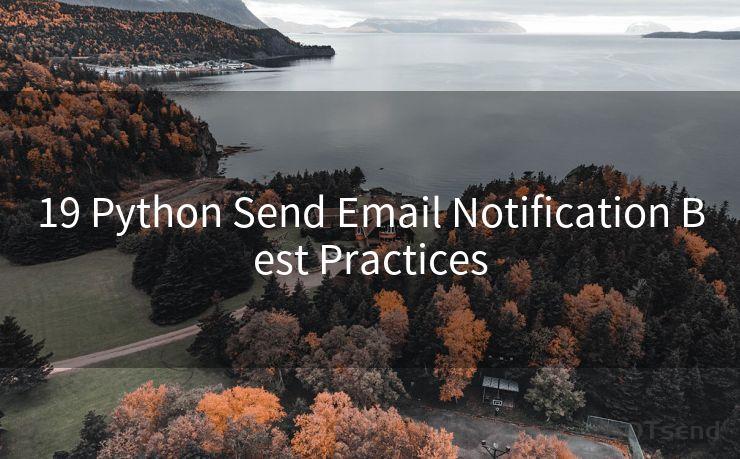19 Python Send Email Notification Best Practices




1. Introduction
When it comes to sending email notifications with Python, there are several best practices to follow to ensure reliability, security, and effectiveness. These practices are crucial for maintaining a robust and efficient email notification system, whether you're sending automated alerts, marketing emails, or any other type of notification.
2. Use a Reliable Email Service Provider
Choosing a reliable email service provider (ESP) is essential for ensuring your emails are delivered successfully. Popular ESPs like SendGrid, Mailgun, or Amazon SES offer robust APIs and deliverability features.
3. Secure Your Credentials
Never hardcode your email credentials in your Python script. Instead, use environment variables or a secure credential storage system to protect your sensitive information.
4. Validate and Sanitize Input
When constructing email messages based on user input, always validate and sanitize the data to prevent email injection attacks. Use libraries like Bleach or html5lib to clean HTML content and avoid potential security risks.
5. Follow Email Standards
Ensure your emails follow the RFC 5322 standard for email format and encoding. This helps in improving deliverability and compatibility with various email clients.
6. Use Templates for Consistency
Utilize templating engines like Jinja2 to create consistent and professional-looking email templates. This not only improves readability but also enhances your brand image.
7. Test Email Deliverability
Regularly test your email deliverability by sending test emails to various email providers. Monitor bounce rates, spam reports, and unsubscribe requests to fine-tune your email sending practices.
8. Handle Unsubscribes Gracefully
Provide a clear and easy way for recipients to unsubscribe from your email notifications. Respecting user preferences is crucial for maintaining a positive sender reputation.
9. Monitor and Log Email Activities
Implement robust logging and monitoring to track email sending activities. This helps in identifying and troubleshooting any issues that may arise.
10. Optimize for Mobile Devices
Ensure your emails are optimized for mobile devices, as a significant portion of email users access their inboxes on the go. Use responsive email templates that adapt to different screen sizes.
11. Consider Privacy Regulations
Be mindful of privacy regulations like GDPR when sending emails. Obtain explicit consent from users before sending them any marketing or promotional emails.
12. Use Appropriate Email Headers
Set appropriate email headers like "From," "Reply-To," and "Subject" to enhance the recipient's experience and improve email deliverability.
13. Avoid Spamming
Don't send unsolicited emails or engage in spamming practices. This can severely damage your sender reputation and lead to blacklisting by email providers.
14. Handle Bounces and Complaints
Implement mechanisms to handle email bounces and complaints gracefully. Use bounce handling libraries to identify and remove invalid or undeliverable email addresses from your list.
15. Use DKIM and SPF Records
Enhance email security by implementing DKIM (DomainKeys Identified Mail) and SPF (Sender Policy Framework) records. These technologies help authenticate your emails and reduce the chances of spoofing or phishing attacks.
16. Send Personalized Emails

🔔🔔🔔
【AOTsend Email API】:AOTsend is a Managed Email Service for sending transactional emails. Support Email Types: reminders, authentication, confirmations, notifications, verification codes, invoices, password resets, account activations, billing statements, two-factor authentication (2FA), and one-time passwords (OTP) emails, etc. $0.28 per 1000 Emails. 99% Delivery, 98% Inbox Rate.
You might be interested in:
Why did we start the AOTsend project, Brand Story?
What is a Managed Email API, How it Works?
Best 25+ Email Marketing Platforms (Authority,Keywords&Traffic Comparison)
Best 24+ Email Marketing Service (Price, Pros&Cons Comparison)
Email APIs vs SMTP: How they Works, Any Difference?
Personalize your emails by including the recipient's name, preferences, or other relevant information. This increases engagement and reduces the chances of your emails being marked as spam.
17. A/B Test Your Emails
Conduct A/B testing to determine the most effective subject lines, content, and call-to-action buttons for your email notifications.
18. Throttle Your Email Sending Rate
Avoid sending too many emails in a short period, which can trigger spam filters. Implement throttling mechanisms to control the rate of email sending.
19. Keep Up with Best Practices
Stay updated with the latest email sending best practices and regulations. This helps you adapt to changing landscapes and ensure your email notifications remain effective and compliant.
By following these 19 best practices, you can significantly improve the reliability, security, and effectiveness of your Python-based email notification system. Remember, sending emails responsibly and with consideration for user experience is key to maintaining a positive sender reputation and ensuring your messages reach their intended recipients.




Scan the QR code to access on your mobile device.
Copyright notice: This article is published by AotSend. Reproduction requires attribution.
Article Link:https://www.mailwot.com/p6283.html



